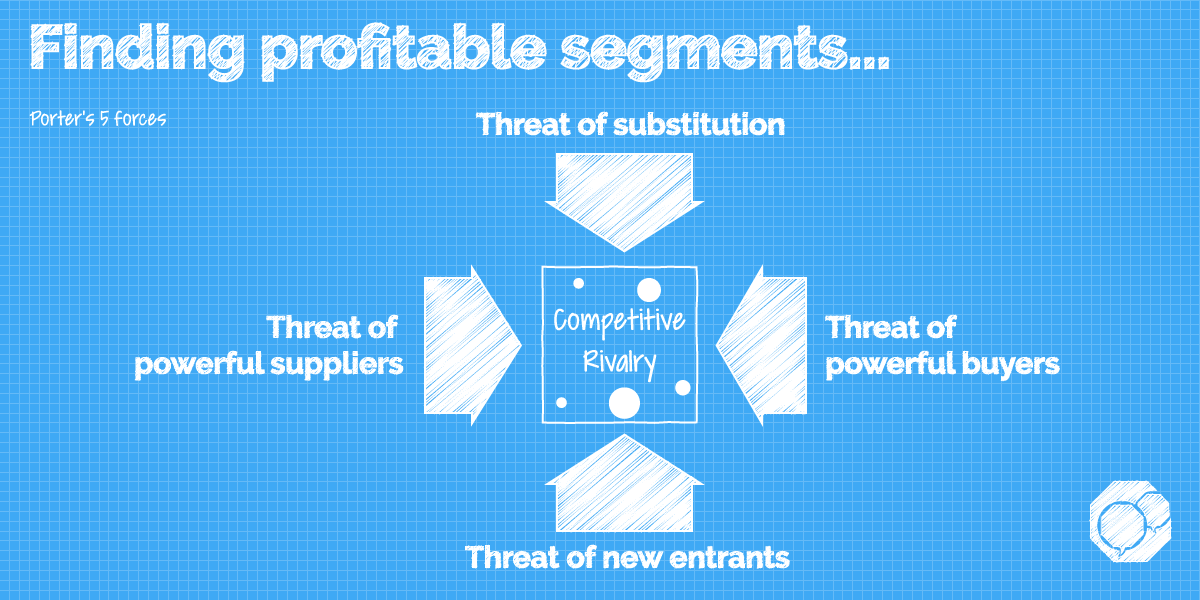>> Return to marketing consultant services...
How profitable is your market segment?

Marketing Cornwall Knowledge Base
Article level - Introduction
Time to read - 5 mins
As a small business, you need to focus your efforts on markets that return profit. I am going to show you a simple business model that you can use to assess how profitable your market segment is.
This model will help you to structure your thinking. It looks at five characteristics of your marketplace. The status of these five traits will impact how profitable the market is. The model will help you to make good decisions about who, what and where to target.
The model is ‘Porter’s 5 Forces Model’. As a marketing consultant, I learnt the 5 Forces model at business school. When we meet and discuss your marketplace, I would use this model to help better understand it.
So what is Porter’s 5 Forces? Michael Porter, American business guru, created the model. He said that there are 5 critical forces pushing and pulling on any marketplace. The situation with each force will either make markets profitable to target or not. You need to be targeting a marketplace that shows profitable signs.
Let’s go through each force…
1. The threat of competitive rivalry
Find out how many other businesses, like yours, are targeting this same segment? If there are lots of competitors then it’s going to be harder to make a profit. Common sense…
How aggressive are these competitors? There might be many, but if they are passive then there could be profitable opportunities.
How much have your competitors invested in this segment? If they have a high investment then they will fight hard to maintain their share of the marketplace.
2. The threat of new entrants
Ask yourself how easy is it for a business to enter the market. Is there a high cost of entry, for example, investing in equipment or other assets? This makes it harder for others to start operating, the threat of new entrants is low.
As a consultant I once worked with a gas engineer in Cornwall. He had a high cost of entry to his market due to all the training and accreditations he needed. This was a good thing for him, it prevented new businesses starting and taking market share.
3. The threat of substitute products
Ask yourself how easy is it for another product to substitute yours. For example, you may need my services as a consultant, but then you might decide to enrol on an evening college course in marketing (naturally, ignore that tip!).
So, if there are lots of substitute products for your product then this is going to be a threat to your profit.
Another example… a family holidaying in Cornwall will be looking for activities for their children. All they need is for their children to have fun and be active. They’re satisfied with a learn to sail course or happy to substitute it for horse-riding.
4. The threat of powerful buyers
A small number of buyers is going to be make them powerful; you will be more dependent on them. This power will allow them to drive down your prices. This situation is going to be a real threat to your business.
For example, if I targeted my products at my local county council then I would only have one to buy from me. I would be better off targeting them across the Country.
5. The threat of powerful suppliers
If you only have a few suppliers, then that is going to make them more powerful. This is especially the case if they have many customers. They’ll be able to drive up their prices which will push down your profit. For example, I am often using Adobe’s software for design. Their software is the premier tool for creating documents. This gives them enormous power in setting the price that I have to pay.
Another example, I once worked with a surfing business in Cornwall. They were renting beach space from the Council. One year the Council decided to increase the price, it had a big knock-on effect for their profit. The surfing business moved their business overseas where their costs would be lower.
There you go, Porters 5 forces… how did you fare? Remember, as you go through each threat think through solutions to each of them.
In our segmentation article we talked about risk assessing your segment. Porter’s 5 forces tool is an excellent model for doing this.
Scoring your 5 forces
With changing market conditions, run the model to see issues that will effect profit. I would recommend grabbing a spreadsheet and listing key factors under each force. Add a score to each of these factors and add them up to find the total threat of a force. Keep track of these over times so that you can track profitability of your market segment.
As a marketing consultant I can help you with using Porter’s 5 Forces. Please get in contact - I’d love to help out.
Further reading
By: Tim Bowerbank
Role: Marketing Consultant